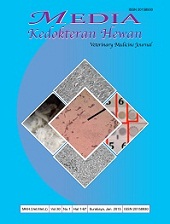TRAUMATIC VENTRICULITIS IN AN AFRICAN OSTRICH: A CASE REPORT
Downloads
Traumatic ventriculitis or hardware disease is the gizzard perforation by sharp foreign bodies (metallic or sharp object) that leads to ulcerative lesions.The present Case Report was to investigate through post mortem examination the cause of African ostrich death. Necropsy was conducted on a dead male adult African Ostrich presented to the postmortem unit of the Department of Veterinary Pathology, University of Ilorin, Ilorin, Nigeria. The gross lesions showed multifocal ecchymotic and petechial haemorrhages and lacerations on the left shank and thigh as well as the cloaca and vent of the bird. A perforation of the proventriculus with adhesion of a pointed nail-like metallic sharp object of 9.4 cm in length was observed. Histopathological findings revealed obliteration of tubular and vascular congestion which predisposed the animal to metabolic disorder.
Aganga, A. A., Aganga, A. O., & Omphile, U. J. (2003). Ostrich feeding and nutrition. Pakistan Journal of Nutrition, 2(2), 60-67.
Al-Abbadi, O. S., Abu-Seida, A. M., & Al-Hussainy, S. M. (2014). Studies on rumen magnet usage to prevent hardware disease in buffaloes. Veterinary World, 7(6).
Cooper, R. G., & Mahroze, K. M. (2004). Anatomy and physiology of the gastro"intestinal tract and growth curves of the ostrich (Struthio camelus). Animal Science Journal, 75(6), 491-498.
Cooper, R. G. (2000). Critical factors in ostrich (Struthio camelus australis) production: a focus on southern Africa. World's Poultry Science Journal, 56(3), 248-265.
Devi Prasad, V., Ravi Kumar, P., Harikrishna, N.V.V. and Bhagyaraju, D. (2017). Traumatic reticulitis, reticulo-peritonitis and pericarditis (Foreign body syndrome) in bovines
Journal of Livestock Science, 8: 98-102.
Smith, D. A. (2020). Ratites. Hand"Rearing Birds, 75-88.
Verwoerd, D. J. (2000). Ostrich diseases. Revue Scientifique et Technique-Office International des Epizooties, 19(2), 638-652.

Veterinary Medicine Journal by Unair is licensed under a Creative Commons Attribution-ShareAlike 4.0 International License.
1. The Journal allows the author to hold the copyright of the article without restrictions.
2. The Journal allows the author(s) to retain publishing rights without restrictions
3. The legal formal aspect of journal publication accessibility refers to Creative Commons Attribution Share-Alike (CC BY-SA).





11.jpg)







11.png)













